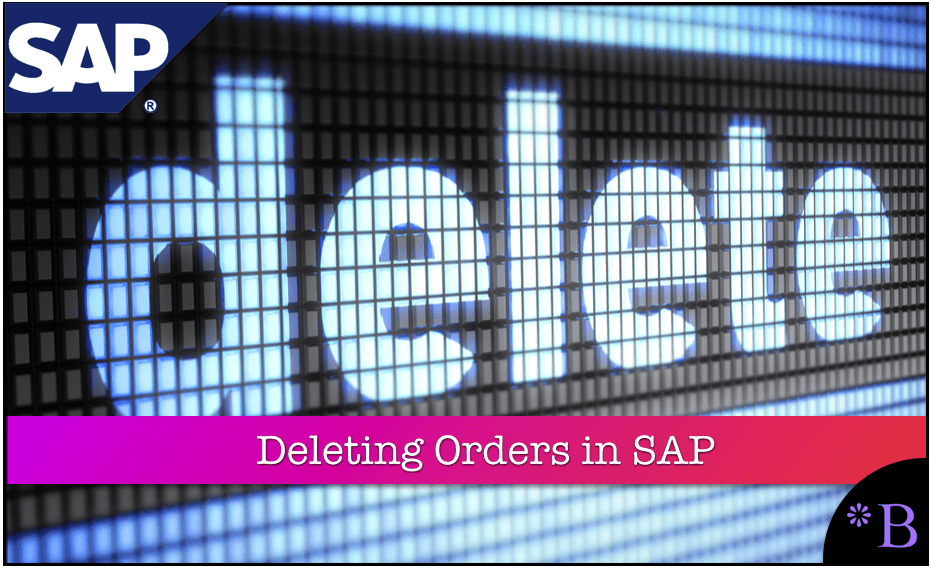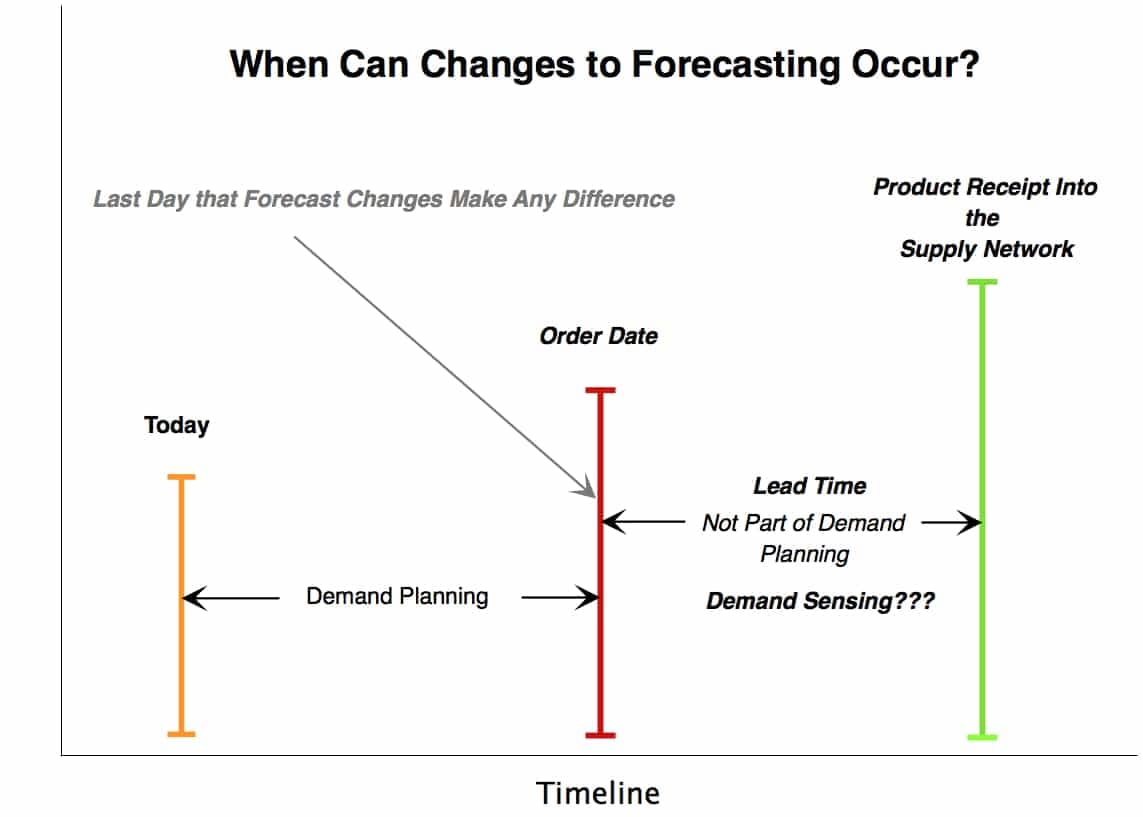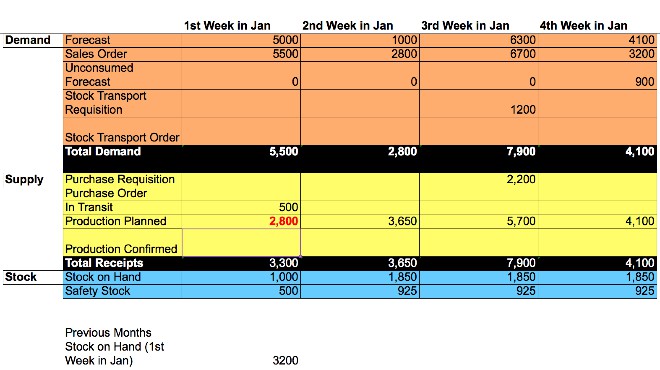How to Delete Old Forecasts from SNP
Executive Summary
- There is a management of sales orders at a VMI location when sales orders are communicated with a lag to the company running APO.
- We cover forward and background consumption.
- Different scenarios between the sales order and forecast must be accounted for.
- These scenarios include when sales orders exactly match the forecast, when sales order exceed the forecast when the forecast exceeds the sales orders within the backward forecast consumption horizon.

Introduction
One issue can surface where are no sales orders in the future at a location. This can occur when a location is primarily a VMI location, if not a VMI location, in actual practice. That means that there can be a customer location whose inventory is managed and, in many cases, owned by the company running APO. It is most common for sales orders to be entered into APO when they are placed. However, there are considerable lags between when the sales orders are accepted and when SNP sees them in some situations.
This is particularly true in VMI situations. The sales orders are accepted by a sales location – customer location, and that sales location has a lag between when they receive sales orders and when they share them with the company running APO.
Forward and Backwards Forecast Consumption
In most cases, there is a relatively short backward consumption set. Forecast consumption, which is described in this article, is a way of preventing the over-ordering that naturally occurs when there are periods where the forecast exceeds sales orders. Forecast consumption can be set both forward and backward and for any horizon (the horizon is set in days in APO). The most common settings for forecast consumption are typically five days. Forward forecast consumption is the most common form of forecast consumption, but it is also quite common for companies to use both backward and forward consumption together. However, setting a forward forecast consumption for this specific requirement, where the company running APO only receives sales orders in the past, would not make any sense.
In this case, it would make more sense to set backward forecast consumption and set the backward forecast consumption horizon in days quite large. This will account for the lag that the company running APO will have in receiving these sales orders. However, three possible scenarios can occur in this design, and each has a different outcome.
The Different Scenarios — Between the Sales Orders and Forecasts — Which Must Be Accounted For
- The Sales Orders Exactly Match the Forecast Within the Backward Forecast Consumption Horizon
- Sales Orders Exceed the Forecast within the Backward Forecast Consumption Horizon
- The Forecast Exceeds the Sales Orders within the Backward Forecast Consumption Horizon
Let’s take a look at each.
The Sales Orders Exactly Match the Forecast Within the Backward Forecast Consumption Horizon
This, of course, the most desirable outcome. It means that there is no adjustment necessary because the forecast and the sales orders perfectly match, and the forecast accuracy over the backward forecast consumption horizon was 100%.
Sales Orders Exceed the Forecast within the Backward The Forecast Consumption Horizon
In this case, there will be an insufficient amount of stock to meet demand. Let us remember that the sales orders arrive after the “current date” and therefore do not drive demand or inventory movements. The response to this is to increase the forecast out into the immediate future periods (one could also add sales orders – as there is no forward forecast consumption in this design). They would not consume the forecast. However, in this case, the design is to add a forecast in a future time bucket. This forecast should be entered (and can easily be entered into the forecast key figure in the SNP planning book) and not be added to the demand planning book. The reason for this is simple – this is not a forecast.
Where Did The Forecast Originate?
The forecast was the original value that was entered into the SNP planning book from DP. Forecasting is the estimation of demand outside of the supply planning lead-time. DP is the “system of record” for forecasts, so any adjustments made in the supply planning system – SNP does not go back to DP. Therefore we have full leeway to change the forecast to meet the parochial needs of supply planning.
Changes to forecasts within the supply planning lead time are not forecasting, although they can be useful, such as in this scenario. However, it should never be used to “adjust” the forecast, or the forecast accuracy will be wrong – this is something that is lost on proponents of demand sensing.
 This brings up the topic of when forecasting changes can be made. As explained in the graphic above, after a certain point, changes are no longer part of forecasting/demand planning, and they do not improve the forecast for apparent reasons. For more on demand sensing – see this article.
This brings up the topic of when forecasting changes can be made. As explained in the graphic above, after a certain point, changes are no longer part of forecasting/demand planning, and they do not improve the forecast for apparent reasons. For more on demand sensing – see this article.
The Forecast Exceeds the Sales Orders within the Backward Forecast Consumption Horizon
This is converse to the previous example. If all the sales orders that will come in over a period have come in and the previous forecast is still higher, there are several alternatives.
- First, the forecast can be deleted in the planning book. The forecast will persist in the initial column – essentially batched for all of the previous forecasts. This forecast initial value column can be deleted completely. However, this cannot be done in mass, and making such changes directly within the planning book has productivity issues. If logic can be developed to program this, then a program can be designed to perform this automatically.
- Second, the elimination of old forecasts can be managed with the backward forecast consumption horizon. If, for instance, the company knows that all sales orders arrive from the VMI partner eight days after the current day, the backward forecast consumption can be set to 8 days. Therefore, when a forecast slips from 8 days old to 9 days old, it no longer drives demand and is, in effect, “deleted” simply because it is no longer recognized. The trick to making the second approach work is to make sure that when the sales orders exceed the forecast, that the forecast is increased in the future, before – in this example, the 8th day passing. There cannot be one backward forecast consumption for conditions where the forecast exceeds sales orders and the converse. Instead, the backward forecast consumption is set to a product location and does not respond to the relationship between sales orders and forecasts.

This example shows how forecast consumption works in a planning book mockup.
Conclusion
The requirement to delete old forecasts under the conditions described in this article and where the forecast exceeds the sales orders must be considered in light of how the company adds forecasts in the future under conditions where the forecast must be added to future periods. It is possible to delete the forecast from the initial period.
However, it is also possible to set the backward forecast consumption horizon so that the forecasts naturally “disappear” from the SNP and do not drive future orders.